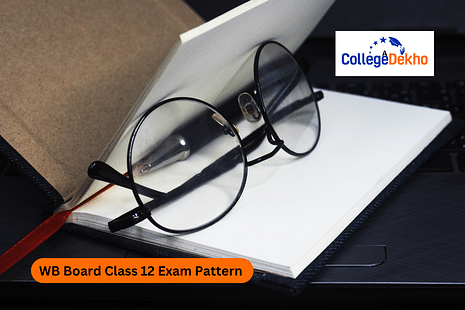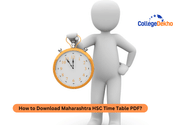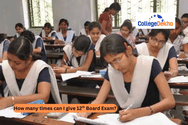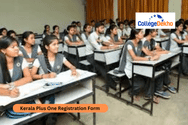West Bengal HS Exam Pattern 2026 is now available on the official website of the West Bengal Council of Higher Secondary Education. A lot of new changes have been recorded in the curriculum to be checked thoroughly by the students.


Never Miss an Exam Update
About West Bengal HS Exam Pattern 2026
The West Bengal HS Exam Pattern 2026 has been revised by WBCHSE and is now available on the official website, wbchse.wb.gov.in. As per the new pattern, Class 12 will follow a semester-based system divided into Semester 3 and Semester 4. In the upcoming board exams, 30% of the questions will be multiple-choice (MCQ) based, while the remaining 70% will be application and descriptive-based. To pass the examination, students must secure at least 30% marks in both theory and practical papers separately. Along with this, the WBCHSE has also reduced the Class 12 syllabus by 30%, and the revised syllabus will now be aligned with the NCERT curriculum. For Music and Visual Arts, both the theory and practical will be conducted for 50 marks each.
The subjects omitted from the curriculum are Gujarati, French, and Punjabi. Students must also download the latest
West Bengal HS Syllabus 2026
to actively prepare for the exam. Read more about the West Bengal HS Exam Pattern 2026 here:
Also Read:
WB HS Previous Year Question Paper
West Bengal HS Exam Pattern 2026: Overview
Check out some highlights regarding the West Bengal HS Exam Pattern 2026 from the table given below and start the preparation for the board exams accordingly:
Exam Mode | Offline |
|---|---|
Medium | Hindi & English |
Duration | 3 Hours |
Type of Questions | Multiple Choice, Long/Short Questions |
Subjects | Hindi, English Mathematics, Science, Social Science, Additional Subject |
Total Marks | 100 |
Theory Exam | 80 |
Internal Assessment | 20 |
Passing Marks | 33% Aggregate in Each Subject & Overall |
West Bengal Class 12 Blueprint 2026
This year, semester-wise exams will be conducted for class 12th students. Students have to select three compulsory elective subjects & one Optional Elective subject from any one of the following sets of subjects:
Sets | Subjects |
|---|---|
Set I | Physics (PHYS) or Nutrition (NUTN) Chemistry (CHEM)or Geography (GEGR) Economics (ECON) or Anthropology (ANTH) or Science of Well Being (SOWB) Mathematics (MATH) or Agriculture(AGRI) Biological Science (BIOS) Statistics (STAT) or Phychology (PSYC) Computer Science (COMS) or Modern Computer Application (COMA) or Environment Studies (ENVS) or Health & Physical Education (HPED) or Visual Arts (VISA) or Music(MUSC) Cyber Security (CBST) or Artificial Intelligence (ARTI) or Data Science (DTSC) One Vocational out of 13 subjects [(1) It & Ites (ITEV), (2) Automobile (ATMV), (3) Organised Retailing (ORTV), (4) Security (SEUV), (5) Health Care (HLCV),, (6) Electronics (ELTV), (7) Tourism & Hospitality (THLV), (8) Plumbing (PLBV), (9) Construction (CNSV), (10) Apparel (APLV), (11) Beauty & Wellness (BWLV), (12) Agriculture (AGLV) & (13) Power (POWV)] ,(14) Banking Financial Services & Insurance (BSIV) ,(15) Food Processing (FDPV), (16) Telecom (TELV) offered by Council which may be selected as optional elective subject only. |
Set II | Accountancy (ACCT) Business Studies (BSTD) Commercial Law and Preliminaries of Auditing (CLPA) or Statistics (STAT) Costing and Taxation (CSTX) Economics (ECON) or Science of Well Being (SOWB) or Applied Artificial Intelligence (APAI) Modern Computer Application (COMA) or Environment Studies (ENVS) or Health & Physical Education (HPED) or Visual Arts (VISA) or Music(MUSC) Mathematics (MATH) One Vocational out of 13 subjects [(1) It & Ites (ITEV), (2) Automobile (ATMV), (3) Organised Retailing (ORTV), (4) Security (SEUV), (5) Health Care (HLCV),, (6) Electronics (ELTV), (7) Tourism & Hospitality (THLV), (8) Plumbing (PLBV), (9) Construction (CNSV), (10) Apparel (APLV), (11) Beauty & Wellness (BWLV), (12) Agriculture (AGLV) & (13) Power (POWV)], (14) Banking Financial Services & Insurance (BSIV) ,(15) Food Processing (FDPV), (16) Telecom (TELV) offered by Council which may be selected as optional elective subject only. |
Set III | Political Science (POLS) or Biological Science (BIOS) Education (EDCN) or Nutrition (NUTN) Journalism & Mass Communication (JMCN) or Sanskrit (SNSK) or Persian (PRSN) or Arabic (ARBC) or Mathematics (MATH) or Agriculture (AGRI) Philosophy (PHIL) Sociology (SOCG) Economics (ECON) or Anthropology (ANTH) or Science of Well Being (SOWB) or Applied Artificial Intelligence (APAI) History (HIST) or Phychology (PSYC) or Statistics (STAT) Geography (GEGR) or Human Development & Resource Management (HDRM) Music (MUSC) or Visual Arts (VISA) or Health & Physical Education (HPED) or Modern Computer Application (COMA) or Environment Studies (ENVS) One Vocational out of 13 subjects [(1) It & Ites (ITEV), (2) Automobile (ATMV), (3) Organised Retailing (ORTV), (4) Security (SEUV), (5) Health Care (HLCV),, (6) Electronics (ELTV), (7) Tourism & Hospitality (THLV), (8) Plumbing (PLBV), (9) Construction (CNSV), (10) Apparel (APLV), (11) Beauty & Wellness (BWLV), (12) Agriculture (AGLV) & (13) Power (POWV)], (14) Banking Financial Services & Insurance (BSIV) ,(15) Food Processing (FDPV), (16) Telecom (TELV) offered by Council which may be selected as optional elective subject only. |
First Language | English (ENGA) Bengali (BNGA) or Hindi (HINA) or Nepali (NEPA) or Urdu (URDU) or Santhali (SANT) or Odia (ODIA) or Telegu (TELG) or Gujarati (GJRT) or Punjabi (PNJB) |
Second Language | Bengali (BNGB) or Hindi (HINB) or Alternative English (ALTE) or Nepali (NEPB) English |
West Bengal HS Exam Pattern 2026: Subject Wise
There are a lot of different subjects included in the curriculum. As mentioned above, there are three sets available for the students to choose from. Check out the subject-wise exam pattern for some of the main subjects of the curriculum from the tables given below:
English
Students can refer to the exam pattern for English from the tables given below for the two semesters included in the curriculum:
Semester 1
Units | Topics | Marks |
|---|---|---|
UNIT 1: PROSE | 1. ‘War’ by Luigi Pirandello | 04 |
2. ‘Debut on Stage’ by Charles Chaplin | 03 | |
3. ‘The Legends of Pensam’ by Mamang Dai | 03 | |
UNIT 2: VERSE | 1. ‘Ode to the West Wind’ by P. B. Shelley | 05 |
2. ‘My Grandmother’s House’ by Kamala Das | 05 | |
UNIT 3: DRAMA | ‘The Glass Menagerie’ by Tennessee Williams (Scene I to IV) | 05 |
UNIT 4: TEXTUAL GRAMMAR | Textual Grammar from Unit 1 and Unit 2: Synthesis and Splitting of Sentences; Change of Narration; Correction of errors | 05 |
UNIT 5: READING COMPREHENSION | Reading Comprehension (Unseen) | 10 |
Total | - | 40 |
Semester 2
Units | Topics | Marks |
|---|---|---|
UNIT 1: PROSE | 1. ‘Mr. Pirzada’ by Jhumpa Lahiri | 9 |
2. ‘The Lamb of the Slaughter’ by Roald Dahl | ||
UNIT 2: VERSE | 1. ‘Last Ride Together’ by Robert Browning | 9 |
2. ‘I cannot live with thee’ by Emily Dickinson | ||
3. ‘This is a Photograph of Me’ by Margaret Atwood | ||
UNIT 3: DRAMA | ‘The Glass Menagerie’ by Tennessee Williams (Scene V to VII) | 05 |
UNIT 4: NONTEXTUAL GRAMMAR | Non-textual Grammar: Synthesis and Splitting of Sentences; Change of Narration; Correction of Errors | 05 |
UNIT 5: WRITING SKILL | Essay | 12 |
Total | - | 40 |
Physics
The Physics theory paper in each semester will be conducted for 35 marks. Check the exam pattern for the same from the tables given below:
Semester 1
UNIT No. | Topics | Marks |
|---|---|---|
1 | Electrostatics | 8 |
2 | Current electricity | 8 |
3 | Magnetic effects of current and magnetism | 8 |
4 | Electromagnetic induction and alternating current | 8 |
5 | Electromagnetic waves | 3 |
Semester 2
| Topic | Short Answer Type Questions Type 1 (2 Marks) | Short Answer Type Questions Type 2 (3 Marks) | Descriptive Type Questions (5 Marks) | Total |
|---|---|---|---|---|
| 1. Optics | 3 × 2 = 6 | 1 × 3 = 3 | 1 × 5 = 5 | 14 |
| 2. Dual Nature of Matter | 2 × 2 = 4 | --- | --- | 4 |
| 3. Atomic Nuclei | --- | 2 × 3 = 6 | --- | 6 |
| 4. Electronic Device | --- | 1 × 3 = 3 | 1 × 5 = 5 | 8 |
| 5. Communication | --- | 1 × 3 = 3 | --- | 3 |
| Total | 10 | 15 | 10 | 35 |
Also Read: WB HS Sample Paper 2026
Chemistry
In Chemistry also, the theory papers will be conducted for 35 marks and the remaining marks will be allotted for the practical exam. Check the exam pattern for the same given below:
UNIT No. | Topics | Marks |
|---|---|---|
Semester 1 | ||
Unit 1 | Liquid state | 8X1=8 |
Unit 2 | p-Block elements (Groups 15, 16, 17 and 18) | 8X1=8 |
Unit 3 | Haloalkanes and haloarenes | 5X1=5 |
Unit 4 | Alcohols, phenols and ethers | 5X1=5 |
Unit 5 | Biomolecules | 5X1=5 |
Unit 6 | Polymers | 4X1=4 |
Semester 2: S: [Short Answer Questions, Descriptive Questions ] MARKS: 35
| TOPIC |
SHORT ANSWER TYPE QUESTIONS
Type 1 (2 marks) |
SHORT ANSWER TYPE QUESTIONS
Type 2 (3 marks) |
DESCRIPTIVE TYPE QUESTIONS
(5 marks) | TOTAL |
|---|---|---|---|---|
| Electrochemistry | 1X2=2 | 1X3=3 | - | 05 |
| Chemical Kinetics | 1X2=2 | - | 1X5=5 | 07 |
| d and f block elements | - | 2X3=6 | - | 06 |
| Co-ordination compounds | 1X2=2 | 1X3=3 | - | 05 |
| Aldehydes, Ketones and Carboxylic Acids | - | - | 1X5=5 | 05 |
| Organic compounds containing Nitrogen | 2X2=4 | 1X3=3 | - | 07 |
| TOTAL | 10 | 15 | 10 | 35 |
Mathematics
The theory paper for Mathematics in each semester will be conducted for 40 marks. Check out the exam pattern regarding the same given below:
Semester 1
Marks: 40 [1 Mark per Question]
| Sl No | Topic | Marks Allotted |
|---|---|---|
| 1 | Relations and Functions, Inverse Trigonometric Functions | 7 × 1 = 7 |
| 2 | Algebra: Matrices and Determinants | 10 × 1 = 10 |
| 3 | Calculus: Continuity & Differentiability, Application of Derivatives | 15 × 1 = 15 |
| 4 | Probability | 8 × 1 = 8 |
| Total | 40 |
Semester 2 Topics
(Short Answer Questions, Descriptive Questions) Marks: 40
| Topic | Short Answer Type Questions (2 Marks) | Descriptive Type Questions (3/4 Marks) | Total |
|---|---|---|---|
| Vectors | 1 × 2 = 2 | 1 × 3 = 3 | 05 |
| Three-Dimensional Geometry | 1 × 2 = 2 (one alternative) | 2 × 4 = 8 (one alternative) | 10 |
| Integrals | 1 × 2 = 2 | 1 × 3 = 3, 1 × 4 = 4 (one alternative) | 09 |
| Application of Integrals | 1 × 2 = 2 (one alternative) | 1 × 4 = 4 | 06 |
| Differential Equation | 1 × 2 = 2 | 3 (one alternative) | 05 |
| Linear Programming | 1 × 2 = 2 (one alternative) | 1 × 3 = 3 | 05 |
| Total | 12 | 28 | 40 |
Economics
Each theory paper in Economics will be conducted for a total of 40 marks. Check out the exam pattern for both semesters from the tables given below:
Semester 1
Unit No. | Topics | Marks |
|---|---|---|
Unit – 1 | Macroeconomics: National Income Accounting | 8 |
Unit – 2 | Macroeconomics: Simple Keynesian System (Closed Economy Model with Government) | 8 |
Unit – 3 | Macroeconomics: Balance of Payments & Exchange Rate | 4 |
Unit – 4 | Indian Economic Development: Brief Reference to Colonial Past | 4 |
Unit – 5 | Indian Economic Development: Evolving Features of Indian Economy | 8 |
Unit – 6 | Indian Economic Development: Agriculture | 8 |
Semester 2
| TOPIC |
SHORT ANSWER TYPE QUESTIONS
Type 1 (2 marks) |
SHORT ANSWER TYPE QUESTIONS
Type 2 (4 marks) |
DESCRIPTIVE TYPE QUESTIONS
(6 marks) | TOTAL |
|---|---|---|---|---|
| Unit 1: Macroeconomics- Money, Banking & Inflation | - | 1X4=4 | 1X6=6 | 10 |
| Unit 2: Macroeconomics – Financing of Government Budget | 3X2=6 | 1X4=4 | - | 10 |
| Unit 3: Indian Economic Development – Industry | 2X2=4 | - | - | 04 |
| Unit 4: Indian Economic Development – International Trade | - | 2X4=8 | - | 08 |
| Unit 5: Indian Economic Development – Challenges & Prospects | 1X2=2 | - | 1X6=6 | 08 |
| TOTAL | 12 | 16 | 12 | 40 |
Accountancy
Accountancy theory exams will be conducted for 40 marks each semester. Check out the exam pattern from the tables given below:
Semester 1
Unit No. | Topics | Marks |
|---|---|---|
Unit 1 | Accounting for Partnership Firms – I | 15 |
Unit 2 | Accounting for Company – I | 10 |
Unit 3 | Analysis of Financial Statements OR Computerized Accounts – I | 15 |
Total | Total | 40 |
Semester 2
| TOPIC |
SHORT ANSWER TYPE QUESTIONS
Type 1 (2 marks) |
SHORT ANSWER TYPE QUESTIONS
Type 2 (3 marks) |
DESCRIPTIVE TYPE QUESTIONS
(5 marks) | Total |
|---|---|---|---|---|
| Accounting for Partnership Firms –II | 3X2=6 | 3X3=9 | 2X5=10 | 25 |
| Accounting for Company-II | 1X2=2 | 1X3=3 | 1X5=5 | 10 |
| Cash Flow Statement OR Computerised Account-II | - | - | 1X5=5 | 05 |
| TOTAL | 08 | 12 | 20 | 40 |
Business Studies
The theory paper in Business Studies will be conducted for a total of 40 marks each semester. Check the exam pattern from the tables given below:
Unit No. | Topics | Marks |
|---|---|---|
Unit 1 | Nature and Significance of Management | 5 |
Unit 2 | Principles of Management | 5 |
Unit 3 | Business Environment | 5 |
Unit 4 | Planning | 7 |
Unit 5 | Organising | 8 |
Unit 6 | Marketing Management | 10 |
Unit 7 | Staffing | 7 |
Unit 8 | Directing | 7 |
Unit 9 | Controlling | 5 |
Unit 10 | Financial Management | 8 |
Unit 11 | Financial Markets | 8 |
Unit 12 | Consumer Protection | 5 |
Total | Total | 80 |
Political Science
The theory paper in Political Science will also be conducted for 40 marks for each semester. Check out the exam pattern for the same from the table given below:
Semester I
Unit No. | Topics | Marks |
|---|---|---|
Unit 1 | International Relations in the Post-Second World War Period | 8 |
Unit 2 | International Organisations and Institutions | 8 |
Unit 3 | Security in the Contemporary World | 7 |
Unit 4 | Challenges of Nation-Building | 5 |
Unit 5 | Political Parties and Party System | 5 |
Unit 6 | India’s Foreign Policy | 7 |
Total | Total | 40 |
Semester II
| Topic | Short Answer Type Questions Type 1 (2 Marks) | Short Answer Type Questions Type 2 (4 Marks) | Descriptive Type Questions (6 Marks) | Total |
|---|---|---|---|---|
| 1. International Relations – Key Concepts and Political Doctrines | 1 × 2 = 2 | --- | 1 × 6 = 6 | 8 |
| 2. Major Regional and Sub-regional Organisations | 1 × 2 = 2 | 1 × 4 = 4 | --- | 6 |
| 3. Globalisation | --- | --- | 1 × 6 = 6 | 6 |
| 4. Organs of the Indian Government | 1 × 2 = 2 | --- | 1 × 6 = 6 | 8 |
| 5. Contemporary Civil Society Movements in India | 1 × 2 = 2 | 1 × 4 = 4 | --- | 6 |
| 6. Constitutional Amendments and Local Self-Government | 1 × 2 = 2 | 1 × 4 = 4 | --- | 6 |
| Total | 10 | 12 | 18 | 40 |
History
In History also, the theory exam will be conducted for a total of 40 marks in each semester in 20 marks will be provided for the project. Check out the exam pattern for the same from the table given below:
Semester 1
Units | Marks |
|---|---|
Unit 1: 1) Through the eyes of the travelers. 2) Cultural amalgamation 3) Imperial capital | 20 |
Unit2: 1) Colonialism and Imperialism in the 19th and 20th Centuries 2) Political basis of Colonialism 3) The levers of Colonial Control | 20 |
Total | 40 |
Semester 2
| TOPIC | SHORT ANSWER TYPE QUESTIONS Type 1 (3 marks) | SHORT ANSWER TYPE QUESTIONS Type 2 (4 marks) | DESCRIPTIVE TYPE QUESTIONS (8 marks) | TOTAL |
|---|---|---|---|---|
| Rebels and Raj | 1X3=3 | 1X4=4 | - | 07 |
| Nationalism and Separatism | 1X3=3 | 2X4=8 | 1X8=8 [ 5+3 OR 4+4 from both the sub-topics ] | 19 |
| Framing of the Constitution | 1X3=3 | 1X4=4 | - | 07 |
| Partition, Nation Formation and Related Aspects | 1X3=3 | 1X4=4 | - | 07 |
West Bengal HS Grading System 2026
WBSCHSE West Bengal HS Grading System 2026 is a seven-point grading system, with the highest grade as A and the lowest being D. Students need to secure at least a Grade 'C' in each compulsory subject as well as in aggregate, to pass the exams:
MARKS SCALE | GRADES | REMARKS |
|---|---|---|
90-100 | AA | Outstanding |
75-89 | A+ | Excellent |
60-74 | A | Very Good |
50-59 | B+ | Good |
40-49 | B | Satisfactory |
30-39 | C | Marginal |
<30 | D | Disqualified |
West Bengal HS Passing Criteria 2026
A student needs to score at least 30% marks in the written paper and the practicals individually to pass the exams. This is also equivalent to a Grade 'C' or more. The students who fail to secure the minimum passing marks will be given the option to appear for the compartment exams. Students can improve their scores and claim their Pass Certificate by clearing the compartment exams.
West Bengal HS Exam Pattern 2026 is needed when starting the preparations for the exams. It will include the name of the units and the weightage allotted for each unit for the particular subjects chosen by the students.
Are you feeling lost and unsure about what career path to take after completing 12th standard?
Say goodbye to confusion and hello to a bright future!

FAQs
To download WB Board Class 12 Exam Pattern 2026, go to the official website of WBCHSE at wbchse.wb.gov.in. Now, click on the Students option on the menu bar. Finally, click on Curriculum & Syllabus.
According to the latest WB Board Class 12 Exam Pattern 2026, there will be two papers for each subject in one academic year. One academic year is divided into two semesters. Theory papers will be conducted for 35 and 40 marks for each semester with practical knowledge and subjects with projects.
As per the WB Board Class 12 Exam Pattern 2026, the question paper will consist of 50% basic questions followed by 30% complex questions and the remaining 20% of questions will be logical and analytical.
Students who will obtain marks between 90-100, will be considered to be passed in distinction division in the West Bengal HS Board 2026.
A minimum of 30% marks are required by the students to clear the West Bengal HS Board 2026.
Was this article helpful?



















